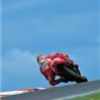Click to read: Benelli Tornado Tre owners reviews, Benelli Tornado Tre specs and to see the Benelli Tornado Tre image gallery.
"We have no gravel traps at Paul Ricard, just large run-off areas covered in abrasive tarmac," the circuit director proudly announced to the assembled journalists. "If you make a mistake then ride over the curbs and brake on the blue and red tarmac strips." Somewhere at the back of the room a voice asked the question on everyone's minds. "What if you're sliding?" "In that case don't slide onto the red strips, they are very abrasive, you'll stop very quickly!" said the director, suddenly looking very serious. Glad we got that cleared up then.
Circuit Paul Ricard has just gone under a massive overhaul thanks to Formula One mogul Bernie Ecclestone. The man with a wad of cash big enough to choke a blue whale has spent a fortune converting the historic circuit, up until 1999 the host of the Bol d'Or 24-hour race, into a purpose built F1 test track. Which explains the lack of gravel traps. It's far better for a multi million pound car to spin to a halt rather than sink up to its axels in gravel. But sandpaper run-off aside the shortened 2.5 mile circuit (no full length Mistral straight, boo!) has everything from 150mph to 20mph braking, walking pace corners, tight left-right chicanes, on and off-camber, fast 100mph plus knee-down and even a long, long right-hander that tightens on the exit to really put a bike through its paces. And the Benelli passed with flying colours.
I was genuinely surprised just how good the Tornado was. The chassis is easily on par, if not better, than the Japanese litre-bikes and feels less nervous. Now a lot of this feeling is probably attributable to the snooker table flat track surface and we will have to see how it deals with the bumps and ruts on UK roads but all the same it was very impressive. On the low speed corners the Tornado takes minimal effort to turn into a corner and goes from upright to knee-down extremely quickly. Usually this would mean that the high speed stability of the bike is compromised but on the Tornado there seem to be no ill effects and it was perfectly stable at around 150mph on the front straight as well as leant over through the 100mph plus right hand turn. According to Benelli the chassis owes all of its development to the World Superbike team.
While on television it may have looked like the Tornado was struggling and off the pace Benelli was actually using all the track testing time and race data to perfect the chassis of the road bike. Probably not the best use of finances but the WSB team did succeed in raising Benelli's profile on the world scene again and has helped produce a very good handling bike, which counts for a lot.
Weight distribution is also a key to the feeling of the Tornado. The under-seat radiator and twin fans may appear a styling exercise to set the bike apart from its rivals but it serves a purpose. With the radiator away from the front of the bike it has allowed Benelli to move the engine further forward in the frame and give the bike a higher weight bias towards the front, with the fans sucking air through the radiator. The Tornado has a 54:46 per cent front to rear weight, compared to a GSX-R1000's 51:49 for example, which helps speed up the handling.
But there are some disadvantages to this system, stability on the brakes for one. The individual pad per piston Brembo brakes bring the bike to a halt very quickly and with loads of feeling but when you are braking hard from high speeds the front end bias of the bike can make the rear end go light. It was most noticeable at the end of the start/finish straight where you are braking hard down from 150mph to around 20mph for a tight right-hand corner. Once the brakes are on the whole bike starts to squirm around the headstock as the weight is thrown forward under deceleration and the rear starts to lift. It's controllable, and the bike doesn't feel as though its about to go side-ways at any second, but the first time it's a bit unnerving and makes you let off the brakes to get the bike settled again. At lower speeds, and with less ferocious braking, it doesn't happen and the brakes and discs, which are the same as the 2002 Aprilia Mille R's, are among the best systems around for power and control.
Another thing that is very noticeable when braking hard into corners is the slipper clutch. Both the Limited Edition and the Biposto use the same slipper-clutch system but where the more expensive Limited has a dry clutch the twin seater uses a more traditional wet clutch. The extra oil on the plates reduces the friction inside the clutch and allows it to slip easier than the dry version. When you're down-shifting while braking the engine's note drops for a fraction of a second while the slipper activates before rising again when the revs catch up. This can be a bit disconcerting when you are about to enter a corner as it seems to take a fraction of a second too long to engage but despite my best efforts, and the lack of weight on the rear because of the braking, the tyre never locked up so it must be effective.
Riding a triple makes a refreshing change from screaming fours or low revving twins. The Novecento Tre, to call it its Italian name, combines the best bits of a twin and four engine, which isn't really surprising when you think about it. The motor pulls cleanly from low down but it isn't until the needle shows around 6,000rpm that most of the power kicks in before it drives to the 11,500rpm redline. Although Benelli claim the Tornado makes 134bhp this is at the crank and I would be surprised it is shows over 115bhp at the rear wheel on a dyno, which isn't necessarily a bad thing. Unlike bikes such as the R1, 'Blade or GSX-R the Tornado never threatens to surprise you by suddenly making the rear break traction which means you can relax a bit more and concentrate on riding the bike using the strong mid-range power.
When the first Limited Edition Tornado's came into the UK they were criticised for poor fuel injection mapping low down which caused the bike to stutter. While the engine is identical on both bikes, with the exception of a few magnesium parts that are aluminium, Benelli has refined the injection mapping and now it's as good as most others on the market, although the progression from fully closed to open throttle is still slightly snatchy.
Visually the £11,500 Biposto and £23,226 Limited Edition Tornado are hard to tell apart, although the pillion pegs are a bit of a giveaway on the Biposto. But underneath the fairing there has been a lot of cost cutting. Everything that was carbon on the Limited is now plastic, magnesium parts are aluminium, the wheels are cast aluminium and not magnesium, suspension is Marzocci and Extremetech instead of Ohlins and the swingarm pivot and headstock are unadjustable. None of the changes make a massive difference to the bike, and the Limited is only 8kg lighter with the exotic material, but for a £12,000 saving I would go for the Biposto.
Production has now started on the Tornado and around 15 bikes a week are rolling off the production line, which makes the Benelli exclusive enough to justify the extra price tag. If it stands the test of time, and proves a success, Benelli is planning to follow the Tornado with a naked version that is due to be show later this year and then possibly even a sports tourer. It looks like the famous Benelli brand will be back, and stronger than ever.
BENELLI TORNADO TRE REVIEW VERDICT
Developing the Tornado has been a huge financial gamble. Creating a bike from scratch is incredibly expensive with costs reaching many millions before a single one rolls off the production line. But it's a gamble that has paid off. The Tornado is a very good bike that can hold its own against other Italian exotica both in looks and performance. The price tag of £11,500 puts it against the Ducati 999 and Aprilia Mille R and styling wise I reckon it has the upper hand on both. The Aprilia's motor feels stronger but through the corners it will be hard to split the three.
EVOLUTION
1999: The Benelli Tornado Tre Novecento is unveiled as a prototype.
2001: On June 24 the Tornado races in World Superbike at Misano, Italy. With Australian Peter Goddard riding it failed to finish the first race and was outside the top 20 in the second, but completed 23 laps.
2002: Benelli produce 150 Limited Edition Tornados costing £23,226 each and the World Superbike team retires from racing.
RIVALS
Ducati 999: £11,250. For many the ultimate Italian stallion. The 999 styling caused a stir when it was unveiled but it handles better than the 998 it replaces and the Testastretta motor is a winner on track and road.
Aprilia RSV-R Mille: £10,199. More understated the Aprilia name isn't as well known outside biking circles as Ducati. Physically bigger than the Duke the Mille with its top quality suspension and radial brakes is one of the best handling bikes around.
Benelli Tornado Tre Specifications
Price new £11,500
Engine capacity 989cc
Power 134bhp@11,250rpm
Torque 68.7lb.ft@9250rpm
Weight 198kg
Fuel capacity 20.5L
Top speed 160mph

